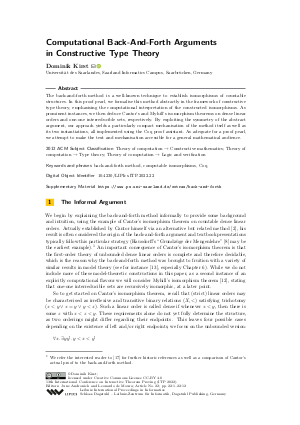Computational Back-And-Forth Arguments in Constructive Type Theory
Author
Dominik Kirst 
-
Part of:
Volume:
13th International Conference on Interactive Theorem Proving (ITP 2022)
Part of: Series: Leibniz International Proceedings in Informatics (LIPIcs)
Part of: Conference: International Conference on Interactive Theorem Proving (ITP) - License:
 Creative Commons Attribution 4.0 International license
Creative Commons Attribution 4.0 International license
- Publication Date: 2022-08-03
File

PDF
LIPIcs.ITP.2022.22.pdf
- Filesize: 0.73 MB
- 12 pages
Document Identifiers
Subject Classification
ACM Subject Classification
- Theory of computation → Constructive mathematics
- Theory of computation → Type theory
- Theory of computation → Logic and verification
Keywords
- back-and-forth method
- computable isomorphisms
- Coq
Metrics
- Access Statistics
-
Total Accesses (updated on a weekly basis)
0PDF Downloads0Metadata Views
Abstract
The back-and-forth method is a well-known technique to establish isomorphisms of countable structures. In this proof pearl, we formalise this method abstractly in the framework of constructive type theory, emphasising the computational interpretation of the constructed isomorphisms. As prominent instances, we then deduce Cantor’s and Myhill’s isomorphism theorems on dense linear orders and one-one interreducible sets, respectively. By exploiting the symmetry of the abstract argument, our approach yields a particularly compact mechanisation of the method itself as well as its two instantiations, all implemented using the Coq proof assistant. As adequate for a proof pearl, we attempt to make the text and mechanisation accessible for a general mathematical audience.
Cite As Get BibTex
Dominik Kirst. Computational Back-And-Forth Arguments in Constructive Type Theory. In 13th International Conference on Interactive Theorem Proving (ITP 2022). Leibniz International Proceedings in Informatics (LIPIcs), Volume 237, pp. 22:1-22:12, Schloss Dagstuhl – Leibniz-Zentrum für Informatik (2022)
https://doi.org/10.4230/LIPIcs.ITP.2022.22
BibTex
@InProceedings{kirst:LIPIcs.ITP.2022.22,
author = {Kirst, Dominik},
title = {{Computational Back-And-Forth Arguments in Constructive Type Theory}},
booktitle = {13th International Conference on Interactive Theorem Proving (ITP 2022)},
pages = {22:1--22:12},
series = {Leibniz International Proceedings in Informatics (LIPIcs)},
ISBN = {978-3-95977-252-5},
ISSN = {1868-8969},
year = {2022},
volume = {237},
editor = {Andronick, June and de Moura, Leonardo},
publisher = {Schloss Dagstuhl -- Leibniz-Zentrum f{\"u}r Informatik},
address = {Dagstuhl, Germany},
URL = {https://drops.dagstuhl.de/entities/document/10.4230/LIPIcs.ITP.2022.22},
URN = {urn:nbn:de:0030-drops-167311},
doi = {10.4230/LIPIcs.ITP.2022.22},
annote = {Keywords: back-and-forth method, computable isomorphisms, Coq}
}
Author Details
Supplementary Materials
References
-
Andrej Bauer. First steps in synthetic computability theory. Electronic Notes in Theoretical Computer Science, 155:5-31, 2006.

-
Georg Cantor. Beiträge zur Begründung der transfiniten Mengenlehre. Mathematische Annalen, 46(4):481-512, 1895.

- Yannick Forster, Felix Jahn, and Gert Smolka. A Constructive and Synthetic Theory of Reducibility: Myhill’s Isomorphism Theorem and Post’s Problem for Many-one and Truth-table Reducibility in Coq (Full Version). working paper or preprint, February 2022. URL: https://hal.inria.fr/hal-03580081.
-
Yannick Forster, Dominik Kirst, and Gert Smolka. On synthetic undecidability in Coq, with an application to the entscheidungsproblem. In Proceedings of the 8th ACM SIGPLAN International Conference on Certified Programs and Proofs, pages 38-51, 2019.

-
Yannick Forster, Dominique Larchey-Wendling, Andrej Dudenhefner, Edith Heiter, Dominik Kirst, Fabian Kunze, Gert Smolka, Simon Spies, Dominik Wehr, and Maximilian Wuttke. A Coq library of undecidable problems. In CoqPL 2020 The Sixth International Workshop on Coq for Programming Languages, 2020.

-
Martin Giese and Arno Schönegge. Any Two Countable, Densely Ordered Sets Without Endpoints are Isomorphic: A Formal Proof with KIV. Univ., Fak. für Informatik, 1995.

-
Paul Halmos and Steven Givant. Introduction to Boolean algebras. Springer, 2009.

-
Felix Hausdorff. Grundzüge der Mengenlehre, 1914.

-
Dominik Kirst and Marc Hermes. Synthetic undecidability and incompleteness of first-order axiom systems in Coq. In 12th International Conference on Interactive Theorem Proving (ITP 2021). Schloss Dagstuhl-Leibniz-Zentrum für Informatik, 2021.

- Evan Marzion. Visualizing Cantor’s theorem on dense linear orders using Coq. Blog post. URL: https://emarzion.github.io/Cantor-Thm/.
-
Alexander G Melnikov and Keng Meng Ng. The back-and-forth method and computability without delay. Israel Journal of Mathematics, 234(2):959-1000, 2019.

-
John Myhill. Creative sets. Journal of Symbolic Logic, 22(1), 1957.

-
Bruno Poizat. A course in model theory: an introduction to contemporary mathematical logic. Springer Science & Business Media, 2012.

-
Pierre Pradic and Chad E. Brown. Cantor-Bernstein implies excluded middle. arXiv preprint arXiv:1904.09193, 2019.

-
Richard Rado. Universal graphs and universal functions. Acta Arithmetica, 9(4):331-340, 1964.

-
Fred Richman. Church’s thesis without tears. The Journal of symbolic logic, 48(3):797-803, 1983.

-
Charles L. Silver. Who invented Cantor’s back-and-forth argument? Modern Logic, 4(1):74-78, 1994.

-
Matthieu Sozeau and Cyprien Mangin. Equations reloaded: High-level dependently-typed functional programming and proving in Coq. Proceedings of the ACM on Programming Languages, 3(ICFP):1-29, 2019.

